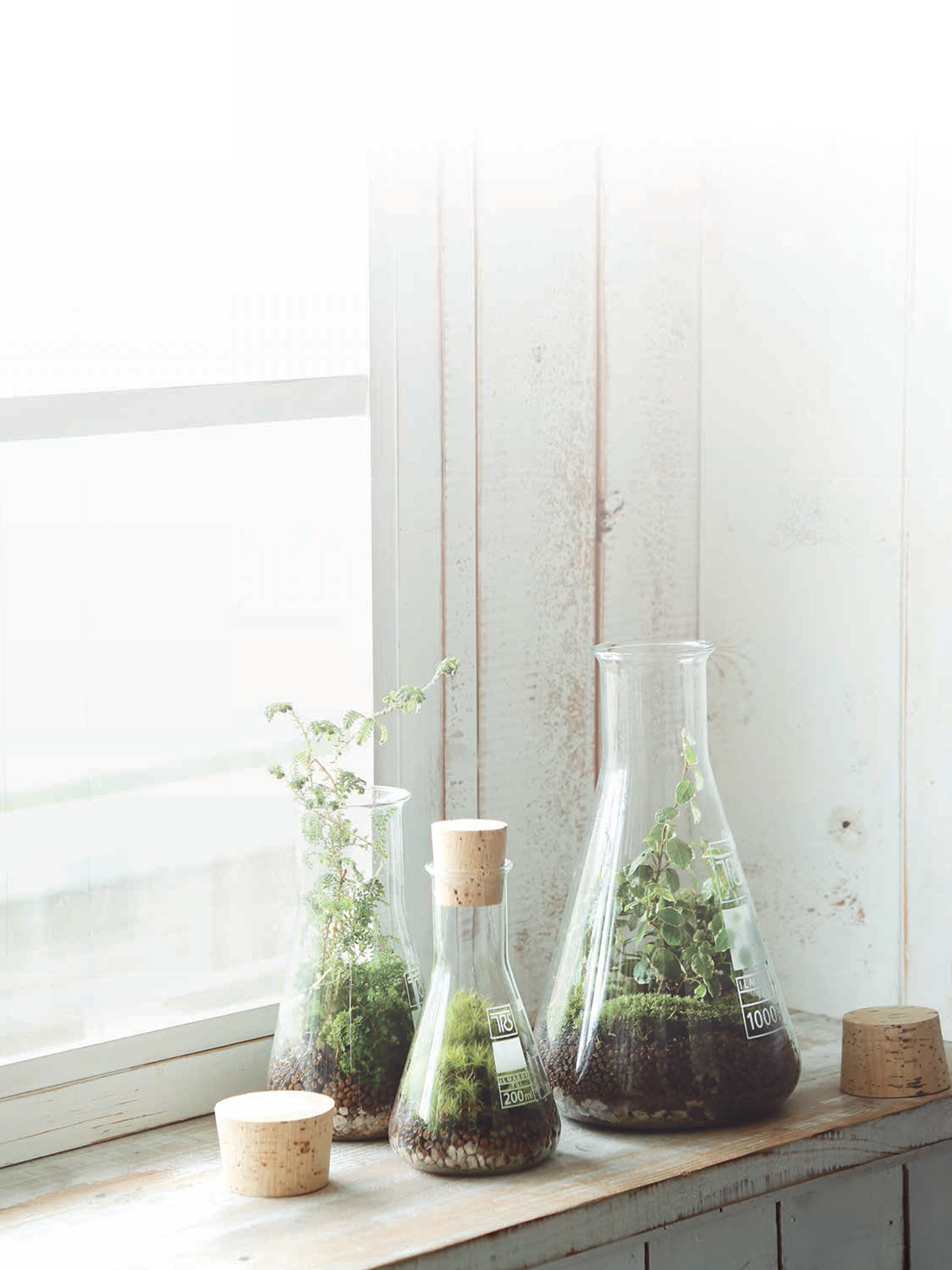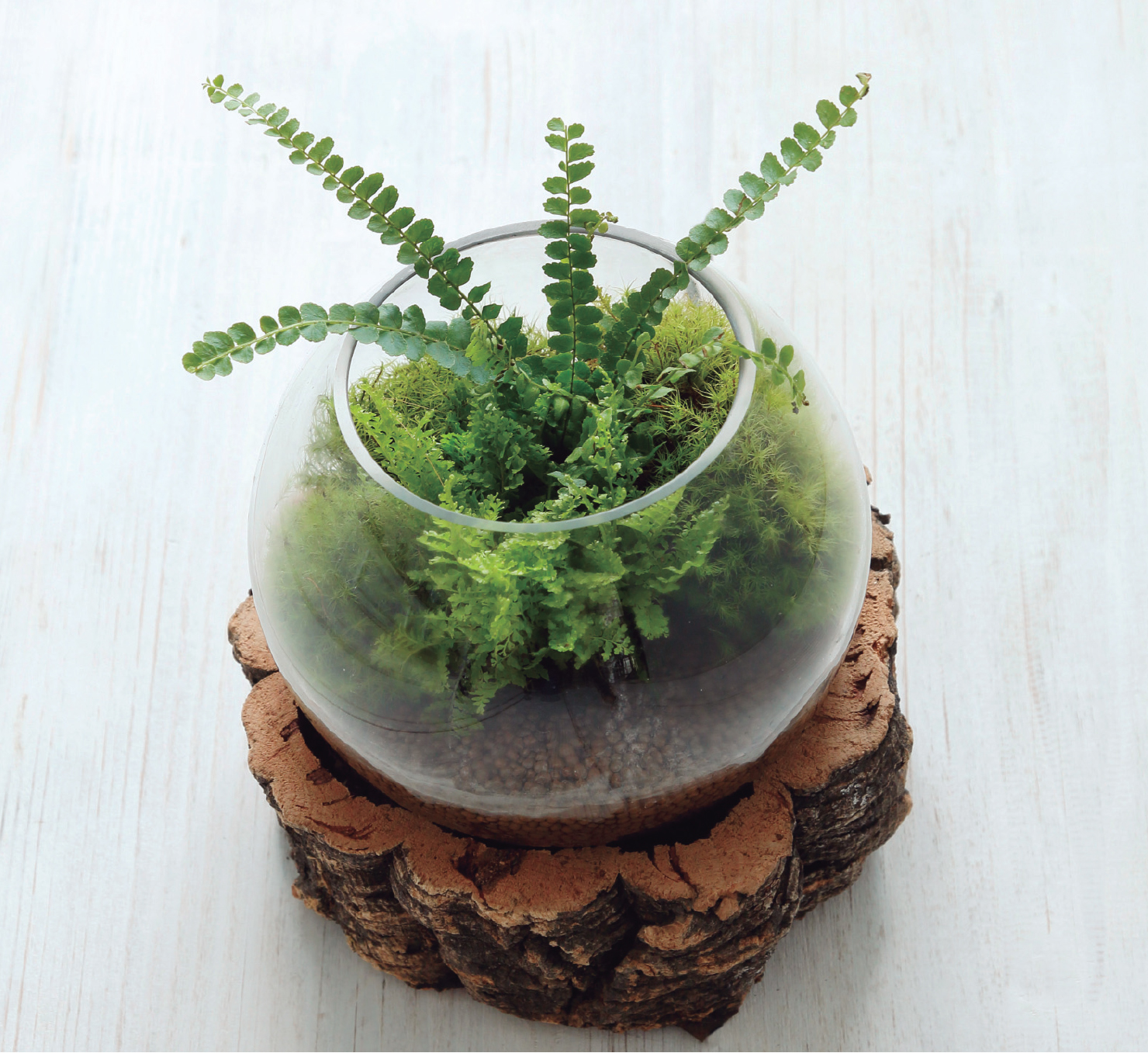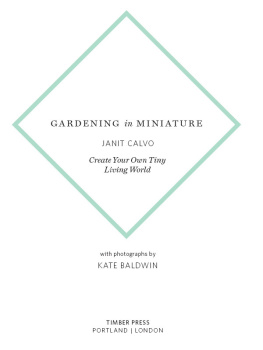
 MINIATURETERRARIUMS
MINIATURETERRARIUMS BY FOURWORDS
BY FOURWORDS  PREFACE Recreating a plants natural environment in a transparent glass container, terrariums are a popular way to bring green into homes and work spaces. Originally devised as a method of transporting plants over an extended period of time, terrariums are now used as a form of small space interior garden, and are often sold at shops selling home goods and furnishings, at specialty garden shops and even at craft stores. This book shows you how easy it is to make your own small-scale terrariums using moss, ferns, air plants and succulents. Terrariums are fun to look at, fun to create and fun to grow. And they are very easy to make and care for, once you know how! Play up the characteristics of particular plants and keep the combination of container and plants in mind when creating your very own unique versions.
PREFACE Recreating a plants natural environment in a transparent glass container, terrariums are a popular way to bring green into homes and work spaces. Originally devised as a method of transporting plants over an extended period of time, terrariums are now used as a form of small space interior garden, and are often sold at shops selling home goods and furnishings, at specialty garden shops and even at craft stores. This book shows you how easy it is to make your own small-scale terrariums using moss, ferns, air plants and succulents. Terrariums are fun to look at, fun to create and fun to grow. And they are very easy to make and care for, once you know how! Play up the characteristics of particular plants and keep the combination of container and plants in mind when creating your very own unique versions.  WHAT IS A TERRARIUM?
WHAT IS A TERRARIUM? A LITTLE GARDEN, CREATED FOR PLEASURE A terrarium is a little garden created for pleasure by cultivating plants in an open or closed transparent container.
A LITTLE GARDEN, CREATED FOR PLEASURE A terrarium is a little garden created for pleasure by cultivating plants in an open or closed transparent container.
Theyre gaining popularity as a source of indoor greenery, as they can be cultivated with minimal wateringlight enters the container and, in the case of closed terrariums, moisture evaporates but cant escape, recirculating and thereby recreating the same cycle as in nature. Terrariums originated in 19thcentury London. It was a time when professional plant collectorsknown as plant hunterstraveled all over the world in search of rare plants and new species to take back to their own countries. But caring for the collected specimens during transport proved difficult. The Wardian case, a sometimes elaborate closed glass container, solved the problem. In 1829, physician and passionate horticulture enthusiast Nathaniel Bagshaw Ward sealed a moths cocoon and some soil in a glass jar and, by coincidence, discovered that a fern and some grass had germinated in the jar.
This proved that if soil absorbed water in the contained environment of a glass vessel, it created the conditions necessary for plants growth, allowing them to be transported for long periods of time. Since then, various forms of Wardian cases spread among the general populace as they allowed anyone to cultivate and style a small garden with ease. These are now known as terrariums.  THE WARDIAN CASE
THE WARDIAN CASE
The forerunner of the modern terrarium, the Wardian case (c.1829) is a closed protective glass case invented by Nathaniel Bagshaw Ward (17911868) in order to shield plants and cocoons from the polluted air of industrial London.  Care The more airtight the container, the better the cycle of moisture, meaning that daily watering isnt necessary.
Care The more airtight the container, the better the cycle of moisture, meaning that daily watering isnt necessary.  Containers As long as the container is made of transparent glass, which maintains a constant temperature, any shape is fine.
Containers As long as the container is made of transparent glass, which maintains a constant temperature, any shape is fine.  Containers As long as the container is made of transparent glass, which maintains a constant temperature, any shape is fine.
Containers As long as the container is made of transparent glass, which maintains a constant temperature, any shape is fine.
There are types with sealable openings and types whose mouths are meant to remain open.  Upgrade your living space Simply adding green to a room makes it a space where you can relax. Why not try incorporating this healing and decorative item into your daily life? Chapter 1WETLAND PLANTSIn this book, this category refers to plants that grow at the edge of water or in swampy areas, dislike strong sunlight and require moist soilincluding ferns, mosses, butterwort and other carnivorous plants. This category is particularly suited to sealable terrariums.
Upgrade your living space Simply adding green to a room makes it a space where you can relax. Why not try incorporating this healing and decorative item into your daily life? Chapter 1WETLAND PLANTSIn this book, this category refers to plants that grow at the edge of water or in swampy areas, dislike strong sunlight and require moist soilincluding ferns, mosses, butterwort and other carnivorous plants. This category is particularly suited to sealable terrariums. Mosses Mosses play a well-known role in bonsai and other types of container gardening. Classified as bryophytes, they grow naturally in various environments such as coastal areas, tropical rainforests, alpine regions and so on. There are over 20,000 species, and most areas where moss grows can boast a number of varieties.
Mosses Mosses play a well-known role in bonsai and other types of container gardening. Classified as bryophytes, they grow naturally in various environments such as coastal areas, tropical rainforests, alpine regions and so on. There are over 20,000 species, and most areas where moss grows can boast a number of varieties.
Mosses have no roots, with only rhizoids to anchor the leaves, stems and body of the plant. For this reason, most mosses tend to grow densely, spreading out to form a large carpet-like colony to maximize moisture retention and create a support system. Most mosses are perennials and so can be enjoyed year-round. Their rich green hues exude an air of harmony and healing despite the modest size of the moss. As moss is unsuited to dry conditions, its leaves wither if it dries out, but it goes into a state of dormancy so there is no cause for concern. It will revive if lightly sprayed with water (a plant mister or spray bottle works well).
Moss requires photosynthesis, so make sure to occasionally place it in soft sunlight to allow it to absorb the suns rays.  Chapter 2TREE-DWELLERSIn this book, tree-dwelling plants refers to air plants and epiphytic plants such as orchids which do not put out roots in soil, but rather attach themselves to trees. These plants are characterized by taking in water and nutrients through their leaves and roots in the manner of cutaneous respiration. They are extremely lightweight so are suited to hanging terrariums.
Chapter 2TREE-DWELLERSIn this book, tree-dwelling plants refers to air plants and epiphytic plants such as orchids which do not put out roots in soil, but rather attach themselves to trees. These plants are characterized by taking in water and nutrients through their leaves and roots in the manner of cutaneous respiration. They are extremely lightweight so are suited to hanging terrariums. Air Plants Found widely across the Americas, air plants are members of the genus Tillandsia in the family Bromeliaceae and are related to the pineapple. They get their common name from the fact that they are not rooted in water or soil, but attach themselves to trees, cliffs and so on. As they require no soil, they lend themselves to all kinds of arrangements.
Air Plants Found widely across the Americas, air plants are members of the genus Tillandsia in the family Bromeliaceae and are related to the pineapple. They get their common name from the fact that they are not rooted in water or soil, but attach themselves to trees, cliffs and so on. As they require no soil, they lend themselves to all kinds of arrangements.
They can be affixed to driftwood or to a brick wall, or planted in any sort of container. Their roots serve mainly to anchor them in place, while trichomeshair-like structures on the surface of the leavesabsorb moisture and nutrients. Air plants can loosely be subdivided into silver-leaved types, so called because the leaves are covered with so many trichomes that they appear white, and green-leaved types which have few trichomes or none at all. As air plants naturally grow in regions where wet and dry seasons are clearly defined, they can tolerate extremes. However, they are actually lovers of moisture, so it is important to water them regularly. Additionally, they like windy conditions and so prefer to be outdoors.
Next page











 MINIATURETERRARIUMS
MINIATURETERRARIUMS BY FOURWORDS
BY FOURWORDS  PREFACE Recreating a plants natural environment in a transparent glass container, terrariums are a popular way to bring green into homes and work spaces. Originally devised as a method of transporting plants over an extended period of time, terrariums are now used as a form of small space interior garden, and are often sold at shops selling home goods and furnishings, at specialty garden shops and even at craft stores. This book shows you how easy it is to make your own small-scale terrariums using moss, ferns, air plants and succulents. Terrariums are fun to look at, fun to create and fun to grow. And they are very easy to make and care for, once you know how! Play up the characteristics of particular plants and keep the combination of container and plants in mind when creating your very own unique versions.
PREFACE Recreating a plants natural environment in a transparent glass container, terrariums are a popular way to bring green into homes and work spaces. Originally devised as a method of transporting plants over an extended period of time, terrariums are now used as a form of small space interior garden, and are often sold at shops selling home goods and furnishings, at specialty garden shops and even at craft stores. This book shows you how easy it is to make your own small-scale terrariums using moss, ferns, air plants and succulents. Terrariums are fun to look at, fun to create and fun to grow. And they are very easy to make and care for, once you know how! Play up the characteristics of particular plants and keep the combination of container and plants in mind when creating your very own unique versions.  WHAT IS A TERRARIUM?
WHAT IS A TERRARIUM? A LITTLE GARDEN, CREATED FOR PLEASURE A terrarium is a little garden created for pleasure by cultivating plants in an open or closed transparent container.
A LITTLE GARDEN, CREATED FOR PLEASURE A terrarium is a little garden created for pleasure by cultivating plants in an open or closed transparent container. THE WARDIAN CASE
THE WARDIAN CASE Care The more airtight the container, the better the cycle of moisture, meaning that daily watering isnt necessary.
Care The more airtight the container, the better the cycle of moisture, meaning that daily watering isnt necessary.  Containers As long as the container is made of transparent glass, which maintains a constant temperature, any shape is fine.
Containers As long as the container is made of transparent glass, which maintains a constant temperature, any shape is fine.  Upgrade your living space Simply adding green to a room makes it a space where you can relax. Why not try incorporating this healing and decorative item into your daily life? Chapter 1WETLAND PLANTSIn this book, this category refers to plants that grow at the edge of water or in swampy areas, dislike strong sunlight and require moist soilincluding ferns, mosses, butterwort and other carnivorous plants. This category is particularly suited to sealable terrariums.
Upgrade your living space Simply adding green to a room makes it a space where you can relax. Why not try incorporating this healing and decorative item into your daily life? Chapter 1WETLAND PLANTSIn this book, this category refers to plants that grow at the edge of water or in swampy areas, dislike strong sunlight and require moist soilincluding ferns, mosses, butterwort and other carnivorous plants. This category is particularly suited to sealable terrariums. Mosses Mosses play a well-known role in bonsai and other types of container gardening. Classified as bryophytes, they grow naturally in various environments such as coastal areas, tropical rainforests, alpine regions and so on. There are over 20,000 species, and most areas where moss grows can boast a number of varieties.
Mosses Mosses play a well-known role in bonsai and other types of container gardening. Classified as bryophytes, they grow naturally in various environments such as coastal areas, tropical rainforests, alpine regions and so on. There are over 20,000 species, and most areas where moss grows can boast a number of varieties. Chapter 2TREE-DWELLERSIn this book, tree-dwelling plants refers to air plants and epiphytic plants such as orchids which do not put out roots in soil, but rather attach themselves to trees. These plants are characterized by taking in water and nutrients through their leaves and roots in the manner of cutaneous respiration. They are extremely lightweight so are suited to hanging terrariums.
Chapter 2TREE-DWELLERSIn this book, tree-dwelling plants refers to air plants and epiphytic plants such as orchids which do not put out roots in soil, but rather attach themselves to trees. These plants are characterized by taking in water and nutrients through their leaves and roots in the manner of cutaneous respiration. They are extremely lightweight so are suited to hanging terrariums. Air Plants Found widely across the Americas, air plants are members of the genus Tillandsia in the family Bromeliaceae and are related to the pineapple. They get their common name from the fact that they are not rooted in water or soil, but attach themselves to trees, cliffs and so on. As they require no soil, they lend themselves to all kinds of arrangements.
Air Plants Found widely across the Americas, air plants are members of the genus Tillandsia in the family Bromeliaceae and are related to the pineapple. They get their common name from the fact that they are not rooted in water or soil, but attach themselves to trees, cliffs and so on. As they require no soil, they lend themselves to all kinds of arrangements.